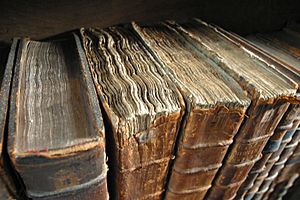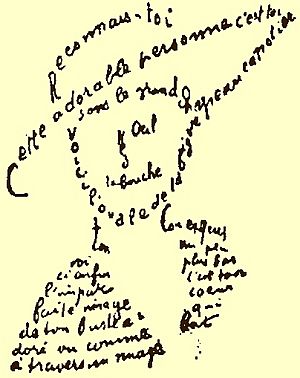Literature facts for kids

Literature is a collection of written or spoken works that are considered art. It uses words to tell stories, share ideas, or express feelings. Most literature is written down, but some stories and poems were first passed on by people telling them to each other.
When we talk about literature, we often mean well-written works like poetry, plays, or novels. These works can be grouped in many ways. For example, they can be grouped by the language they are written in, the time period they come from, or their type (genre). The word literature comes from a Latin word meaning "learning" or "writing."
Some of the oldest literary works are epic poems. These are long stories about heroes and their adventures. Famous examples include the Ramayana and Mahabharata from India. The Greek poems Odyssey and Iliad by Homer are also very old. They were first told aloud and later written down around 800 BC.
Major Forms of Literature
Literature comes in many forms, each with its own special way of using words.
Poetry
Poetry is a type of literature that uses language in a special way. It often focuses on the sound and rhythm of words. Poems can make you feel certain emotions or think about things in new ways.
Unlike regular writing (called prose), poetry is usually set in lines instead of sentences. The way words are arranged in a poem can be just as important as their meaning. For a long time, poetry was defined by its rhythm and lines. Poetry might even be older than writing itself, as many early poems were spoken and remembered.
Prose
Prose is the most common form of written language. It uses ordinary syntax and natural speech patterns. This means it flows like everyday conversation or writing, using sentences and paragraphs. Prose is different from poetry because it does not usually have a set rhythm or line structure.
- Novel: A novel is a long fictional story written in prose. Novels often explore real-life situations and characters. The word "novel" first meant "news" and later came to mean something new, whether true or made up. Modern novels became popular around the 1700s. Today, they are one of the most popular types of literature.
- Novella: A novella is a story that is shorter than a novel but longer than a short story. There isn't an exact rule for how many words a novella should have. Publishers and literary awards often have their own ideas about its length. Because of its size, a novella can have some of the depth of a novel and some of the focus of a short story.
- Short story: A short story is a brief fictional narrative. It's hard to say exactly when short stories began. Some people think the earliest short narratives, like those in the Bible, were short stories. Others point to writers like Edgar Allan Poe or Anton Chekhov as early masters of the modern short story. Short stories are usually focused on a single event or a few characters.
Drama
Drama is literature that is meant to be performed. This can include plays, which are written works by a playwright for the stage. Plays mostly use dialogue (talking) between characters. They are usually meant to be seen in a theater rather than just read.
Sometimes, a play is written only to be read. This is called a closet drama. Its full meaning can be understood just by reading it on the page. For a long time, almost all drama was written in verse, like poetry.
Greek drama is one of the earliest forms of drama we know a lot about. Tragedy was a type of play performed at religious and civic festivals. These plays often told serious stories based on well-known historical events or myths.
With new technology, drama has moved beyond the stage. For example, War of the Worlds (radio) in 1938 was a famous radio play. Many plays have also been made into films or television shows. And sometimes, stories from TV, movies, or radio are turned into books.
Related pages
Images for kids
-
The Adventures of Pinocchio (1883) is a canonical piece of children's literature and one of the best-selling books ever published.
-
A traditional Kyrgyz manaschi performing part of the Epic of Manas at a yurt camp in Karakol, Kyrgyzstan
-
Limestone Kish tablet from Sumer with pictographic writing; may be the earliest known writing, 3500 BC. Ashmolean Museum
-
Egyptian hieroglyphs with cartouches for the name "Ramesses II", from the Luxor Temple, New Kingdom
-
The intricate frontispiece of the Diamond Sutra from Tang dynasty China, the world's earliest dated printed book, AD 868 (British Library)
-
Sculpture in Berlin depicting a stack of books on which are inscribed the names of great German writers.
-
Cover of a 1921 libretto for Giordano's opera Andrea Chénier
-
The Library of the Palais Bourbon in Paris
-
Soviet poet Anna Akhmatova (1922), whose works were condemned and censored by the Stalinist authorities
See also
 In Spanish: Literatura para niños
In Spanish: Literatura para niños













